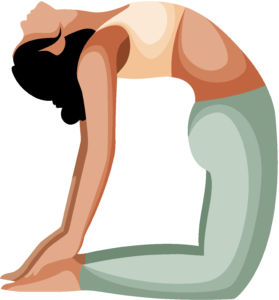Camel (Ustrasana)
Pose Overview
| Common Name | Camel |
| Traditional Sanskrit Name | Ustrasana |
| Sanskrit Name Pronunciation | oos-tra-SA-na |
| Pose Difficulty | Intermediate |
| Drishti
Drishti is the gaze or visual focus point during yoga poses.
Learn more about Drishti |
Upward, towards the sky |
Camel Pose, also known as Ustrasana, is a deep backbend that strengthens the back and opens the chest. This pose is often used to improve flexibility in the spine and is a common pose in many yoga practices. The name Ustrasana comes from the Sanskrit words "ustra" meaning "camel" and "asana" meaning "pose."
Benefits of Camel
Strengthens the back muscles Opens the chest and improves flexibility in the spine Improves posture Stimulates the thyroid and pineal glands Increases energy Helps alleviate stress and anxiety
How to Enter Camel
Begin on your knees with your knees hip-width apart and your thighs perpendicular to the floor. Place your hands on the lower back, fingers pointing down. Slowly lift your chest and press the hips forward as you reach back with one hand at a time to grab the heel. Keep your head up and your gaze forward.
How to Exit Camel
Release the heels and slowly lower your torso back onto your knees. Rest in Child's Pose for a few breaths before returning to your starting position.
Common Camel Modifications & Variations
If it is difficult to reach the heels, you can use a block for support. You can also try doing the pose with your hands on your lower back instead of reaching for the heels.
Common Mistakes with Camel
Rounding the back instead of keeping it straight Pushing the hips too far forward Not keeping the head up and gaze forward
Safety Guidance
Be careful not to push your body too far if you have any neck or back injuries. Do not do this pose if you have high blood pressure or a migraine.

